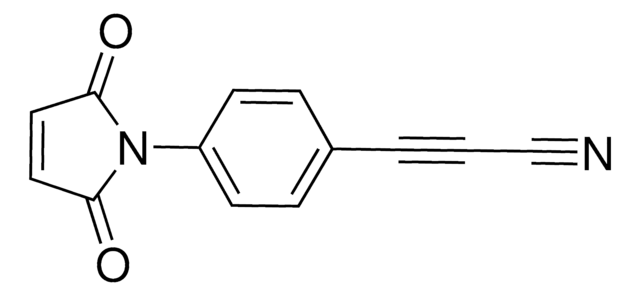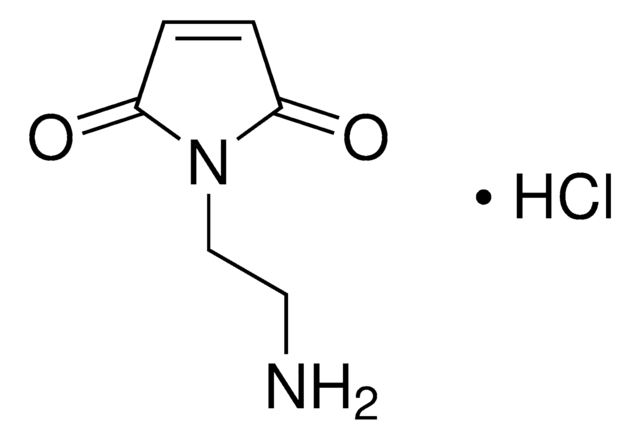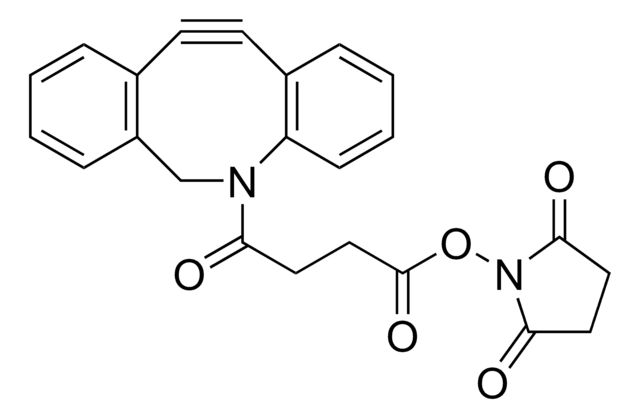推薦產品
形狀
powder
品質等級
反應適用性
reagent type: cross-linking reagent
官能基
ester
儲存溫度
−20°C
SMILES 字串
O=C(OC1=C(F)C(F)=C(S(=O)(O[Na])=O)C(F)=C1F)C2=CC=C(C#CC#N)C=C2
InChI
1S/C16H5F4NO5S.Na/c17-10-12(19)15(27(23,24)25)13(20)11(18)14(10)26-16(22)9-5-3-8(4-6-9)2-1-7-21;/h3-6H,(H,23,24,25);/q;+1/p-1
InChI 密鑰
YFJYSJRZDOWXDH-UHFFFAOYSA-M
一般說明
CBTF (Sodium 4-((4-(cyanoethynyl)benzoyl)oxy)-2,3,5,6-tetrafluorobenzenesulfonate) is a heterobifunctional reagent. It bears a 3-arylpropionitrile (APN) group. CBTF can be prepared from 4-iodobenzoic acid. It participates in various amine-to-thiol coupling reactions. It participates in the synthesis of various antibody-dye conjugates. CBTF is widely used for antibody conjugation.
應用
CBTF is a bifunctional crosslinker for amine-to-thiol coupling. The coupling can be performed with high selectivity in biological medium using mild reaction conditions. CBTF readily reacts with organic amines in basic conditions to produce APN-probes suitable for cysteine labeling.
其他說明
Standard protein labeling procedure (lysine labeling):
Standard protein labeling procedure (cysteine labeling):
Dissolve the protein in the appropriate buffer* with pH 6.5-9.0 (e.g. PBS) at 1-10mg/mL concentration.
Apply the appropriate amount of the stock solution of the APN-labeled molecule (1-5 molar eq. per free cysteine residue).
Incubate at room temperature for 2 hours.
If necessary, purify the protein conjugate using size exclusion chromatography or ultrafiltration.
*Note: avoid amine- and thiol-containing buffers.
- Dissolve the protein in an appropriate buffer* with pH 7.5-9.0 (e.g. PBS) at 1-10mg/mL concentration.
- Apply the appropriate amount of the stock solution of the reagent (1-5 molar eq. per lysine residue).
- Incubate at room temperature for 2 hours.
- If necessary, purify the protein-APN conjugate using size exclusion chromatography or ultrafiltration.
- The conjugate can be readily coupled with thiol-containing substrates by incubating the components in aqueous buffer (pH 6.5-9.0) at ambient temperature for 2 hours.
Standard protein labeling procedure (cysteine labeling):
Dissolve the protein in the appropriate buffer* with pH 6.5-9.0 (e.g. PBS) at 1-10mg/mL concentration.
Apply the appropriate amount of the stock solution of the APN-labeled molecule (1-5 molar eq. per free cysteine residue).
Incubate at room temperature for 2 hours.
If necessary, purify the protein conjugate using size exclusion chromatography or ultrafiltration.
*Note: avoid amine- and thiol-containing buffers.
訊號詞
Danger
危險聲明
危險分類
Acute Tox. 3 Oral
儲存類別代碼
6.1C - Combustible acute toxic Cat.3 / toxic compounds or compounds which causing chronic effects
水污染物質分類(WGK)
WGK 3
閃點(°F)
Not applicable
閃點(°C)
Not applicable
客戶也查看了
Houzong Yao et al.
International journal of molecular sciences, 17(2), doi:10-doi:10 (2016-02-06)
Antibody-drug conjugates (ADCs) have become a promising targeted therapy strategy that combines the specificity, favorable pharmacokinetics and biodistributions of antibodies with the destructive potential of highly potent drugs. One of the biggest challenges in the development of ADCs is the
Construction of homogeneous antibody-drug conjugates using site-selective protein chemistry.
Akkapeddi P, et al.
Chemical Science, 7(5), 2954-2963 (2016)
Sergii Kolodych et al.
Bioconjugate chemistry, 26(2), 197-200 (2015-01-24)
Amine-to-thiol coupling is the most common route for the preparation of antibody-drug conjugates (ADC). It is usually achieved by using heterobifunctional reagents possessing an activated ester at one end and a maleimide group at the other. However, maleimide-based conjugates were
我們的科學家團隊在所有研究領域都有豐富的經驗,包括生命科學、材料科學、化學合成、色譜、分析等.
聯絡技術服務









![(1R,8S,9s)-双环[6.1.0]壬-4-炔-9-基甲基 N-琥珀酰亚胺碳酸酯 for Copper-free Click Chemistry](/deepweb/assets/sigmaaldrich/product/structures/969/022/d6776082-2f7a-47c7-bcd4-3830dac0fb7d/640/d6776082-2f7a-47c7-bcd4-3830dac0fb7d.png)
